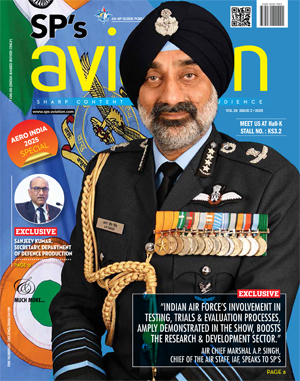INDIAN ARMED FORCES CHIEFS ON OUR RELENTLESS AND FOCUSED PUBLISHING EFFORTS

The insightful articles, inspiring narrations and analytical perspectives presented by the Editorial Team, establish an alluring connect with the reader. My compliments and best wishes to SP Guide Publications.

"Over the past 60 years, the growth of SP Guide Publications has mirrored the rising stature of Indian Navy. Its well-researched and informative magazines on Defence and Aerospace sector have served to shape an educated opinion of our military personnel, policy makers and the public alike. I wish SP's Publication team continued success, fair winds and following seas in all future endeavour!"

Since, its inception in 1964, SP Guide Publications has consistently demonstrated commitment to high-quality journalism in the aerospace and defence sectors, earning a well-deserved reputation as Asia's largest media house in this domain. I wish SP Guide Publications continued success in its pursuit of excellence.
Finally - Boost For Industry
India is poised to be the next MRO hub in South Asia in the next five years with all the advantages it will build in that time

March 14, 2020 was a milestone day in the history Of Indian Maintenance, Repair and Overhaul (MRO) Industry. On this day, the Goods and Services Tax (GST) Council at its 39th meeting took some concrete steps to boost the Indian MRO Industry with its recommendation to reduce GST on MRO services in respect to aircraft from 18 per cent to five per cent with full ITC and to change the place of supply for B2B MRO services to the location of the recipient. This change is likely to assist in setting up of MRO services in India. Domestic MRO will also get protection due to five per cent tax paid under section 3(7) of the Customs Tariff Act, 1975 on most imported goods including those sent abroad for repairs, as this tax is available for credit. This comes into effect from April 01, 2020.
MRO Association of India, a not-for-profit professional body, has been engaging with the Ministries of the Government of India to seek this benefit since the introduction of GST in India on July 1, 2017. Earlier, the Association was able to procure a Zero rate of Custom Duties from the Ministry of Finance in its General Budget for Financial Year 2012-13.
The Indian MRO Industry is still in its nascent stage. India has a pool of talent in both experienced and youth categories of human resources. The country also offers the cheapest manhour cost of $43, the lowest in the region, but the high taxation regime was eroding its MRO business. With the much need relief provided by the Government, the Indian MRO Industry now feels that it can turn the tide in its favour.
The GST Council’s decision to reduce GST from 18 per cent to five per cent will see overseas MROs and original equipment manufacturers (OEMs) to invest in India in the area of MRO to the tune of millions of dollars. Some the overseas companies operating in India, have expressed their desire to do so. Others have already done so and will benefit from this decision of the Government of India.
The present Central Government under its ‘Make in India’ programme, is keen to develop the Indian aviation and aerospace industry. The MRO industry is part of this initiative. The Government of India is not only keen to strengthen its MRO industry, it is also looking at building a robust ecosystem to fuel its growth. It plans to make a leasing hub in India with all tax benefits, engaging OEMs to build components in India at a lower cost, impart world class aviation training thereby providing employment to not only the youth of India, but also reemploying the defence veterans through Recognition of Prior Learning (RPL) programme through the Aerospace and Aviation Sector Skill Council (AASSC).
With close to 900 commercial aircraft, 1,100 Business and General Aviation aircraft including helicopters and over 2,500 aircraft, helicopters and Unmanned Aerial Vehicles (UAVs) in the fleets of the Indian Armed Forces, it is imperative for India to rise up to exploit the opportunities and confront the challenges that lie ahead.
The present Central Government under its ‘Make in India’ programme, is keen to develop the Indian Aviation and Aerospace industry. The MRO industry is part of this initiative. The Government of India is not only keen to strengthen its MRO industry, it is also looking at building a robust ecosystem to fuel its growth.
There are regular engagements between the Ministry of Civil Aviation (MoCA) and the Ministry of Defence (MoD) and their respective arms to build a net of cooperation between both the sides.
With the Government paving the way for growth for the Indian aviation industry, particularly the MRO industry, it is expected that in the times ahead, Indian operators of both civil and military aircraft will use the services of the Indian MROs and stop spending the country’s precious foreign exchange. It is also expected that overseas companies will set up shops for MRO services either on their own or through joint ventures with their Indian companies. Same goes also for training manpower and manufacturing segments as well.
MoCA is engaging with the leasing companies on a regular basis to impress upon them to set up their leasing arms in India with the growing fleet of Indian Airlines, which is expected to grow exponentially in the next five years. The Government pressure on them to put up manufacturing plants in India to support this growth of the Indian aviation industry.
It is high time that India should formulate a Civil Offsets Policy for all purchases for Civil Aviation to cover commercial aircraft and aviation equipment. The Policy should lay down goals, roadmap, timelines for technology and for infrastructure ramp up, with business-friendly rules and processes, to harness the buying power.
Setting up of MRO Centres should be an avenue for Offset discharge, which would provide the opportunity for private airlines to join as partners, apart from reduction in the cost of MRO services. The Government should mandate private airlines to create a Consortium for managing Offsets to ensure that specific capabilities are built up to cover design and development, manufacture, testing, MRO and logistics infrastructure for the supply of spares. It maybe of interest to note that a step in this direction was taken long ago when a small Offset clause was invoked by the then Civil Aviation Ministry when the country’s national carriers bought several Boeing and Airbus aircraft to add to their fleets. Through these Offset programmes, aircraft exit doors, fuselages, digitalizing designs, putting up MROs and training facilities by these companies were started.
It may be of interest to know that the Indian MRO firms are securing business from foreign airlines in the neighborhood and earning sizeable amount of foreign exchange for the country. This business can also be expected to grow further in the near term.
India is poised to be the next MRO hub in South Asia in the next five years with all the advantages it will build in that time. More so, the Indian MRO Industry will be able to get back its experienced workforce from the neighboring countries, who have gone there in search of greener pastures.
The MRO Association of India is hopeful that with continued support from the Government, India can be built up as an MRO hub in the region in the next half a decade. The way forward for the Indian MRO industry looks bright.
The author is the Founder Secretary General of MRO Association of India.





